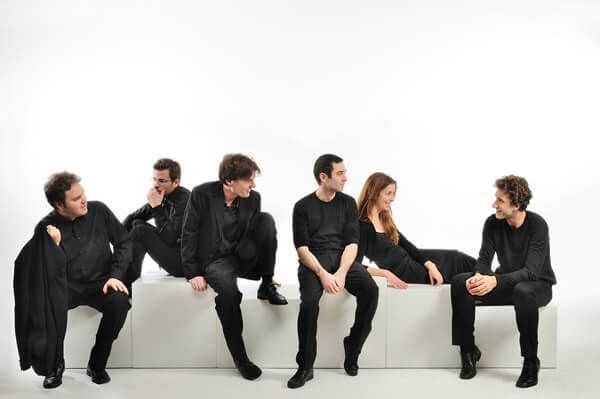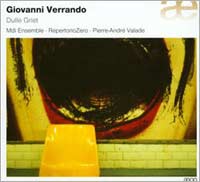 Mellifluous gondoliers, bloodthirsty La Scala patrons, and rotund Neapolitans belting “O sole mio”: for too long, these conventional images have obscured Italy’s considerable new music achievements. Sure, Nono, Berio, and Sciarrino are widely admired as modern masters and great innovators, but for every Scelsi out there you can find ten further Italians who have yet to receive their due. Per esempio: Busoni and Russolo, who virtually invented the concept of “experimental music”; the neoclassicism of Malipiero, Casella, and the generazione dell’ottanta; Dallapicolla and Petrassi, with their inventive, lyrical adaptations of the twelve-tone system; the internationalist visions of Maderna and Clementi; Bussotti and his wild neo-Dada extravagances; the quiet, inimitable alchemy of Castiglioni and Donatoni; and the diverse younger generation of Stroppa, Gervasoni, Billone, and Romitelli, the last of whom succeeded, almost impossibly, in marrying Bang on a Can with IRCAM. If there’s a country out there with a more diverse cast of compositional characters, the UN forgot to make them a member state.
Mellifluous gondoliers, bloodthirsty La Scala patrons, and rotund Neapolitans belting “O sole mio”: for too long, these conventional images have obscured Italy’s considerable new music achievements. Sure, Nono, Berio, and Sciarrino are widely admired as modern masters and great innovators, but for every Scelsi out there you can find ten further Italians who have yet to receive their due. Per esempio: Busoni and Russolo, who virtually invented the concept of “experimental music”; the neoclassicism of Malipiero, Casella, and the generazione dell’ottanta; Dallapicolla and Petrassi, with their inventive, lyrical adaptations of the twelve-tone system; the internationalist visions of Maderna and Clementi; Bussotti and his wild neo-Dada extravagances; the quiet, inimitable alchemy of Castiglioni and Donatoni; and the diverse younger generation of Stroppa, Gervasoni, Billone, and Romitelli, the last of whom succeeded, almost impossibly, in marrying Bang on a Can with IRCAM. If there’s a country out there with a more diverse cast of compositional characters, the UN forgot to make them a member state.

Giovanni Verrrando
To this list should now most emphatically be added Giovanni Verrando, whose new aeon portrait disc Dulle Griet provides a bracing, scintillating introduction to a compositional sensibility refreshingly bold and probing. For sure, you could make the argument that Verrando takes up right where Romitelli left off, since the two share a good many of the same aesthetic genes. Thus, like his sadly missed colleague, Verrando allies a fundamentally French post-spectral sensibility (picked up from studies with Tristan Murail) with an abiding interest in the grittier edges of the popular music spectrum (the liner notes cite the Red Hot Chili Peppers’ “Californication”). To these, in turn, is typically added a healthy dose of “Italianate” lyricism and levity. The balance is especially well-exemplified in the album’s acoustic pieces, such as the colorful Il ruvido dettaglio celebrato da Aby Warburg (2002), whose coruscating arpeggios put one in mind of Berio’s “points on the curve to find…”. Similarly, in the tantalizingly short First Born Unicorn, remind me what we’re fighting for (2001), Verrando isn’t afraid to let the solo flute warble and sing, breaking the intensely hushed atmosphere.

mid ensemble
However, in the pieces for amplified instruments, such as Triptych #2 (2008), performed here in a cameo appearance by RepertorioZero, the “electrified ensemble” Verrando helped found, the balance tips in favor of the more indefinite sounds of industrial rock and ambient music. Here, Verrando arguably goes farther than Romitelli, producing something like Lachenmann’s musique concrète instrumentale with amplified instruments (“electric” strings, samplers, and guitars). In the title piece, Dulle Griet (2010), the result is somewhat vague, coming across at times like a taped “soundscape.” Even here, though, one can’t help but be impressed by composer’s ability to conjure up all manner of quasi-synthesized, musique concrète-like timbres without recourse to electronic manipulation or Pro Tools fiddling. By way of contrast, Triptych #2 takes a considerably more systematic approach, to greater effect. The focus is now on distortion, the archetypical sound of an overdriven guitar, which Verrando simulates with furious violin scratch tone tremolos. In the movement titled “Harmonic domains #3,” all the lo-fi grit, fuzz, and “noise” of punk are translated into spectral terms – the concept of inharmonicity – the result being a striking etude exploring the various ways in which the direct perception of pitch can be obscured using rock instrumentation. In this regard, at least, Third Born Unicorn, remind me what we’re fighting for (2009) is the most fully-realized work on the disc, completely transforming the timbre of the violin, that most respectable of classical instruments, into something utterly alien and abrasive. (However, Verrando “cheats” a bit in Third Born Unicorn, since it’s the only piece on the album that calls for direct electronic manipulation.) Indeed, the work ends with a noise that sounds for all the world like the guitar flubs with which so many of the great punk songs end.
 Like Berio, Verrando’s music also reflects interdisciplinary concerns and the latest developments in humanities research. In the program notes for the pieces included on this disc alone, Verrando alludes to the ideas of economist Jacques Attali, literary theorist Roland Barthes, and philosopher Michel Serres. Most pertinent in this context is Serres, whose definition of noise (in the information theory sense of the word) Verrando quotes: “How much noise must be made to silence noise?” Serres’ essential point is that distortion and disruption are endemic to the transmission of any message. This idea has fascinating consequences for Verrando’s compositional practice: if “noise” (“inharmonicity”) is inevitable, the opposite (“harmonicity”) cannot be in any sense thought of as normative. Consequently, if the “threshold state” (as Gérard Grisey was wont to put it) is the basic condition of all music, then a black-and-white dichotomy between refractory distortion and a message well-received cannot be maintained. Verrando brings this insight to bear on the second movement of the solo piano Second Born Unicorn, remind me what we’re fighting for (2002). The short piece slowly and methodically outlines a basic generative chord, one of those highly-resonant, sort-of-consonant-sort-of-dissonant chords the spectral composers were so fond of. Though the chord is finally allowed to ring in all its sonorous finery, a niggling percussive sound, achieved by preparing the piano’s very highest key, is continually butting in, disrupting the sense of fulfillment.
Like Berio, Verrando’s music also reflects interdisciplinary concerns and the latest developments in humanities research. In the program notes for the pieces included on this disc alone, Verrando alludes to the ideas of economist Jacques Attali, literary theorist Roland Barthes, and philosopher Michel Serres. Most pertinent in this context is Serres, whose definition of noise (in the information theory sense of the word) Verrando quotes: “How much noise must be made to silence noise?” Serres’ essential point is that distortion and disruption are endemic to the transmission of any message. This idea has fascinating consequences for Verrando’s compositional practice: if “noise” (“inharmonicity”) is inevitable, the opposite (“harmonicity”) cannot be in any sense thought of as normative. Consequently, if the “threshold state” (as Gérard Grisey was wont to put it) is the basic condition of all music, then a black-and-white dichotomy between refractory distortion and a message well-received cannot be maintained. Verrando brings this insight to bear on the second movement of the solo piano Second Born Unicorn, remind me what we’re fighting for (2002). The short piece slowly and methodically outlines a basic generative chord, one of those highly-resonant, sort-of-consonant-sort-of-dissonant chords the spectral composers were so fond of. Though the chord is finally allowed to ring in all its sonorous finery, a niggling percussive sound, achieved by preparing the piano’s very highest key, is continually butting in, disrupting the sense of fulfillment.
For all that, I’m firmly convinced that Verrando’s best work is still ahead of him. The two varieties of piece on display in Dulle Griet, the acoustic harmonic and “noisy” electric, sit uneasily next to one another. The true achievement would be to synthesize the fine-grained harmonic sensibility of the earlier works with the electro-Lachenmannian soundscapes of the newer ones. Whatever the case, it’s clear Verrando’s not one for sitting on his laurels; he’s not afraid to court the anomalous. This comes across well in the Third String Quartet (2003), ostensibly the most traditional piece on the album. Though its simple harmonies and nervous minimalist twittering make it the odd man out in Verrando’s oeuvre, the Quartet’s engrossing shifts and understated mastery make it a worthy contribution to the con fragilità aesthetic pioneered by Sciarrino.
This is music that demands total commitment, and in the mdi Ensemble Verrando has found a talented band of performers who can give just that. In sum: an unusual disc that will appeal to all manner of new music lover.
Giovanni Verrando/mdi ensemble/RepertorioZero/Pierre-André Valade, Dulle Griet (aeon, 2013) | Buy it on Amazon.com | Amazon.ca | Amazon.co.uk





















